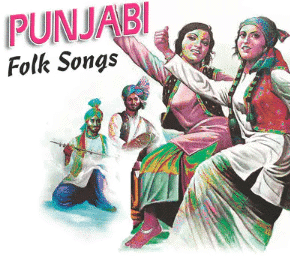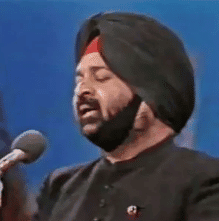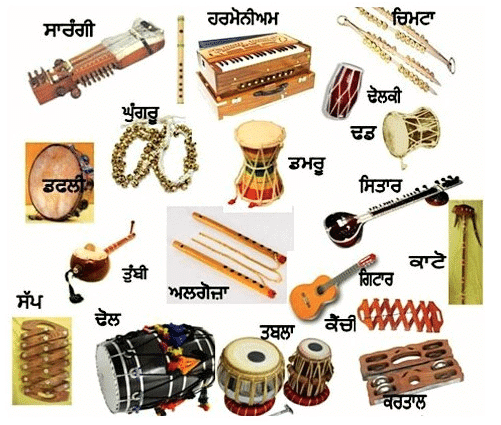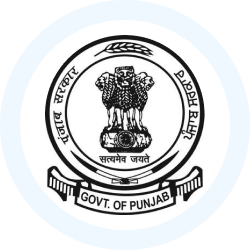Folk Music of Punjab | Punjab State (PPSC) PSC: Preparation - PPSC PCS (Punjab) PDF Download
Folk Songs of Punjab
Traditional Punjabi music is primarily composed of local folk music, which is an integral part of the culture. Punjabi folk songs are sung in the rural language of Punjab and reflect the daily lives, traditions, and emotions of the people.

Patiala Gharana
- The Patiala Gharana is the most renowned musical gharana (school of music) in the state of Punjab. It is known for its rich contribution to classical and folk music.
Categories of Folk Songs
Occasional Songs: These are songs dedicated to specific ceremonies such as:
- Birth Ceremonies
- Marriage Ceremonies
- Death Ceremonies
- Love Songs: Expressing themes of love and romance.
- Festival Songs: Celebrating various festivals with joy and enthusiasm.
- Occupation/Leisure Songs: Reflecting the daily occupations and leisure activities of the people.
- Battle Songs: Commemorating battles and warrior traditions.
Gurmat Sangeet and Sufi Music
- Gurmat Sangeet: This is a form of devotional music that is rooted in the teachings of Sikh Gurus. It is characterized by its spiritual themes and use of traditional instruments.
- Sufi Music: Sufi music in Punjab is known for its mystical and spiritual themes, often conveying messages of love, peace, and devotion.
Songs for Birth Ceremonies
Punjabi folk songs vividly portray the life cycle from birth to death. Various songs are sung during different rituals at the birth of a son.
These include:
- Putra Janam: These songs are sung on the occasion of a child's birth.
- Naam Karan: These songs are sung during the naming ceremony of the child.
- Mundan: These songs are sung at the time of the hair removal ceremony, known as Mundan.
Songs for Wedding Ceremonies
In Punjab, various types of songs are sung during wedding ceremonies.
Ghorian and Suhaag
- Ghorian are joyous songs sung in the groom's house to express happiness, while Suhaag songs, sung by the bride's family, convey a mix of joy and sorrow.
Jago
- Jago folk songs are an integral part of Punjabi weddings, used to welcome the bride to her husband's home. The Jago ceremony, held the night before the wedding or during the mehndi night, involves singing and dancing around a brightly decorated jug, symbolizing festivity.
Doli Songs
- Doli songs are sung during the departure of the bride in the Doli. This moment is filled with mixed emotions as the bride bids farewell to her parents and parental home while anticipating her new life with her husband. These songs are known for their emotional depth.
Songs of Bridegroom’s and Bride’s Side
- Different types of songs are sung during various occasions of marriage. Songs from the bridegroom’s side include: Mangane de geet, Sohhle, Chounki, Charan Vele de geet, Ghorian, Sehra, and Pani Varna. Songs from the bride’s side include: Chura, Charan Vele de geet, Janj, Milni, Ghanne de geet, and Siftan.
Festival Songs in Punjab
Punjab is known for its vibrant and joyful festival songs that are an integral part of various celebrations. Some of the most popular festival songs include those sung during Baisakhi, Lohri, and Teeyan.
Baisakhi Songs
- Baisakhi is a time of great joy and celebration, and singing and dancing are natural expressions of this happiness. During Baisakhi, young boys and girls in Punjab dress in their colorful traditional attire and come out to the fields to participate in Baisakhi folk songs.
- These songs reflect the joy of farmers who are delighted with the bountiful harvest during this time. Folk songs during Baisakhi can include love songs and other fast-paced songs that add to the festive spirit.
Lohri Songs
- Lohri songs are an essential part of the Lohri festival. These songs are typically sung at night when family members gather around the bonfire to dance and celebrate together. There are various types of Lohri songs that capture the essence of this joyful occasion.
Teeyan Songs
- Teeyan, also known as Teej, is celebrated in the month of Sawan (July) and is a special time for married girls to visit their parents and relive the carefree days of their childhood. During this festival, girls sing songs and dance with great enthusiasm.
- Teeyan songs are often filled with emotions and themes of love. Girls celebrate this occasion by swinging on swings, wearing new clothes, enjoying special dishes, and singing unique songs that are characteristic of Teeyan.
Love Songs
- Love lyrics are a cherished part of Punjabi folklore, capturing the joy of union and the sorrow of separation. These songs are often associated with famous love stories such as Heer Ranjha, Sohni Mahiwal, Sassi Punnu, and Mirza Sahiban. Popular forms of love songs in the state include Boli, Dhola, and Mahiya, which are discussed below:
Boli Songs
- Boli songs are the most popular form of folk music in Eastern Punjab.
- They are typically one-line couplets and represent the most concise style of folk song.
- Despite their brevity, Boli songs are deep, impactful, and interesting, expressing a wide range of emotions.
- A Boli can have anywhere from one to several lines.
- Bhangra and Giddha, the two famous folk dances of Punjab, are performed to the accompaniment of Boli songs.
Dhola Songs
- Dhola songs are another popular form of folk music in Punjab.
- These songs are highly lyrical and sentimental, with love and beauty as their main themes.
- Each stanza typically consists of five lines, which can be divided into two parts: the first part has three lines, and the second part is a couplet that enhances the meaning of the first three lines.
- The rhythm of Dhola songs varies according to the emotions being expressed, and the singers are often the folk poets of these songs.
Mahiya Songs
- Mahiya songs originated in Western Pakistan but are now sung all over India.
- These songs are performed by young women expressing their longing for their husbands.
- The word “Balo. is often included in these songs, and the structure is in a question-and-answer format.
- A triplet of Mahiya is called a Tappa, as it resonates with the heartbeat of the singers.
- The term “Mahiya. comes from “Mahi,” meaning lover, and the legendary lover Ranjha was referred to as Mahi.
- Mahiya songs use touching expressions of love and pathos to address the lover.
Occupation/Leisure Songs
Women in Punjab sing Trinjan and Phulkari songs while doing their work. These songs are an important part of their culture and reflect their dreams, fears, and friendships.
Trinjan Songs
- Trinjan songs are sung by women while they spin the wheel.
- Trinjan refers to the spinning sessions held at night, where women gather at someone's house to spin and sing together.
- Chiri Chirunga is the day session of spinning, while Rat Katni is the night session.
- During these sessions, women express their dreams, aspirations, fears, and love through the songs.
- Trinjan sessions also help in forming lifelong friendships among women.
- Sometimes, there are spinning competitions among young girls with a chain of songs in the background.
Phulkari Songs
- Phulkari is a traditional textile art of Punjab, created by Punjabi women.
- When working on a Phulkari, women sing Phulkari songs together in a group.
- When embroidering a Phulkari for a bride, women sing suhag songs that depict the bride's future life and offer her good wishes.
- If the Phulkari is embroidered in the bridegroom's family, women sing ghori songs.
Baramah: A Seasonal Song
- The term 'Baramah' refers to the twelve months of the year. This song expresses deep feelings of separation and longing. Among these twelve months, Sawan is particularly cherished in folk songs.
Battle Songs
- Battle songs hold historical significance and reflect the Punjabi community's attitude towards past events, especially foreign invasions. Punjab, being a frontier province, has experienced the aftermath of various invasions, which brought suffering, plunder, and violence.
- These songs often depict the terror instilled by invaders like Nadir Shah and Ahmad Shah Abdali. Additionally, some folk songs allude to rebellion movements within Punjab.
Alahunian: Death Ceremony Song
- Alahunian is a traditional song sung after the death of a person.
- The song highlights the good qualities of the deceased, the impermanence of life, and the seeming nature of the world.
- In villages, a lead singer known as marashan performs the alahunian at a funeral.
- The words spoken by the marashan are called alahunian, and the rest of the mourners repeat these lines.
Gurmat Sangeet
- Gurmat Sangeet, also known as Shabad Kirtan, features the hymns (bani) of Saints and Sikh Gurus.
- It is a blend of devotional, folk, and classical music.
- The singing style used in Gurmat Sangeet is called Pard taal, which has its roots in dhrupad and khayal music.
- The folk traditions of Gurmat Sangeet were preserved by Guru Nanak Dev Ji's disciples, Bala, a Hindu, and Mardana, a Muslim.
Sufi Music in Punjab
Sufi music is a form of devotional music that holds a significant place in Punjab's cultural heritage. The Sikh Dhadhi tradition is a renowned style of Sufi music in the state. This tradition involves the use of the sarangi (a bowed string instrument) and the dhadh (a hand-held, hourglass-shaped drum).
Historical Background
- The Dhadhi tradition originated during the time of the great Sikh gurus. Guru Har Gobind Ji, for instance, would invite skilled musicians to perform in his court to inspire courage and bravery within the Sikh community.
- Both Muslim and Sikh Dhadhi musicians were welcomed in the Guru’s courts, performing together and contributing to the musical heritage.
Evolution of the Tradition
- As the Sufi tradition spread, Muslim Dhadhi performers began to incorporate Sufi compositions into their repertoire, blending these with Sikh devotional music.
- This fusion reflects the harmonious relationship between different musical and devotional traditions in Punjab.
Patiala Gharana
The Patiala gharana is a prominent school of vocal Hindustani classical music. It was established by Fateh Ali Khan and Ali Baksh Khan and received initial support from the Maharaja of Patiala in Punjab. This gharana is particularly renowned for its styles of singing, including ghazal, thumri, and khayal.
Folk Singers of Punjab
Asa Singh Mastana

Asa Singh Mastana (1926-1999) was a celebrated Punjabi musician and singer, famous for his contributions to folk music and his impactful voice in Bollywood films.
- He gained widespread recognition for his rendition in the Bollywood film Heer, which showcased his exceptional talent and helped popularize Punjabi folk music.
- Some of his most well-known songs include ‘Balle Ni Panjaab Diye Sher Bachiye’, ‘Doli Charhdeyan Marian Heer Cheekaan’, and ‘Kali Teri Gut’. These songs have laid the foundation for future Punjabi musicians and are considered classics.
- Asa Singh Mastana was also known for his poignant sad songs, such as ‘Jadon Meri Arthi Utha Ke Chalan Ge’, as well as upbeat tracks like ‘Main Jatt Yamla Pagla Deewana’, which was dramatized on the popular actor Dharmendra.
- Throughout his career, he often collaborated with other renowned singers like Surinder Kaur and Parkash Kaur, creating many memorable folk songs that resonated with audiences and became a significant part of Punjabi culture.
Gurmeet Bawa
- Gurmeet Bawa is renowned for her exceptional ability to hold a long hekh, which is a breathless opening of a Punjabi folk song that starts with 'ho.' She can sustain this note for about 45 seconds. Bawa is also one of the singers who popularized Jugni and made history as the first Punjabi female singer to perform on Doordarshan.
- Throughout her career, she has received numerous national and international awards. These include the State Award from the Punjab Government in 1991, the Sangeet Puraskar from the Punjab Natak Akademi, the Millennium 2000 Award from the American Biographical Institute of New York, the National Devi Ahilya Award from the Madhya Pradesh Government in 2002, and the Shiromani Gayika Award from the Punjabi language department in 2008.
Gurdas Maan
- Gurdas Maan, an iconic figure in Punjabi music, hails from the village of Giddarbaha in Punjab. He shot to fame in 1980 with his hit song ‘Dil Da Mamla Hai’. Renowned as a singer, songwriter, choreographer, and actor, Maan is celebrated for his significant contributions to Punjabi music.
- Over his illustrious career, he has recorded more than 34 albums and penned over 305 songs. His work has been recognized internationally, winning the ‘Best International Album’ at the UK Asian Music Awards in 2009 for ‘Boot Polishan’.
- Maan's talent was further acknowledged in 2007 when he received the National Film Award for Best Male Playback Singer for his poignant song ‘Couplets of Heer’ in the film Waris Shah: Ishq Daa Waaris.
Hans Raj Hans
Early Life and Career
- Hans Raj Hans was born in the village of Safipur, located in Jalandhar, Punjab.
- He began his career by performing at youth festivals and gained recognition by winning various musical competitions.
Musical Journey
- After establishing himself, he started singing Punjabi folk, devotional, and Sufi music.
- Hans Raj Hans collaborated with renowned artists, including the legendary Nusrat Fateh Ali Khan, in the film Kachche Dhaage .
Recognition and Awards
- He was honored with the title of honorary music Professor at prestigious institutions such as Washington DC University and San Jose State University.
Lal Chand Yamla
- Lal Chand Yamla, popularly known as Yamla Jatt, was a renowned folk singer from Punjab.
Musical Style and Influence
- He was famous for his gentle strumming of the tumbi, a traditional Punjabi instrument, and his unique turban-tying style called 'Turla'.
- Many consider him a pioneer of Punjabi music and a key figure in the development of contemporary music in East Punjab.
Awards and Recognition
- In 1956, he received a Gold Medal from Indian Prime Minister Pt. Jawaharlal Nehru.
- In 1989, he was honored with a Lifetime Contribution Award by the National Academy of Dance, Drama, and Music in Delhi.
Narinder Biba
- Narinder Biba, also known as Bibaji, was a famous Punjabi singer from East Punjab. She was renowned for her soulful renditions of Punjabi folklore, love stories such as Mirza Sahiban and Sassi Punnu, and historical Sikh events like the Saka Sirhind. Her music captured the essence of Punjabi culture and history. Narinder Biba was married to Jaspal Singh, a talented Algoza player.
Nooran Sisters
- Jyoti Nooran and Sultana Nooran are Sufi singers hailing from the Sham Chaurasia gharana of classical music in Jalandhar. The sisters were trained in music for a decade by their father, Ustad Gulshan Mir. They gained recognition in Bollywood with their debut in the movie "Highway" in 2014, where they worked with the renowned music director AR Rahman. Since then, they have lent their voices to various films, showcasing their exceptional talent in Sufi music.
- Shamshad Begum, born on November 25, 1929, and passed away on June 15, 2006, was a pioneering Punjabi singer and songwriter. She is credited with popularizing the genre of Punjabi folk songs and earned the title of the Nightingale of Punjab. In addition to her folk singing career, Shamshad Begum also worked as a playback singer in Hindi films between 1948 and 1952, showcasing her versatility and talent in the music industry.
Sardool Sikander
- Sardool Sikander, a renowned Punjabi folk singer often referred to as 'The King of Bhangra,' hails from Kheri Naudh Singh in the Fatehgarh Sahib district of Punjab. He is a proud member of the Patiala Gharana, a prestigious musical lineage. Sikander gained recognition in the early 1980s when he made his debut on radio and television with his album 'Roadways Di Laari.'
Wadali Brothers
- The Wadali Brothers, Puranchand Wadali and Pyarelal Wadali, are esteemed Sufi singers and musicians originating from Guru Ki Wadali in the Amritsar district of Punjab. They were honored with the Punjab Sangeet Natak Akademi Award in 2003, and Puranchand Wadali received the Padma Shri award from the Government of India in 2005. Pyarelal Wadali passed away on March 9, 2018.
Musical Instruments of Punjab

Punjab's folk music is rich and diverse, featuring a variety of traditional musical instruments that are integral to dances like Bhangra and Giddha. These instruments play a vital role in cultural activities and are deeply rooted in the region's heritage.
Traditional Musical Instruments of Punjab
Jori:
- The Jori, also known as a pair of wooden flutes, is a traditional instrument played by folk singers in Punjab. It is played by a single person using three fingers on each side. The Jori is commonly used in folk singing and dancing, accompanying songs like Mirza, Challa, and Jugni.
Bugchu:
- The Bugchu is a unique stringed instrument crafted from a dried gourd (Ghia). To make this instrument, a piece of skin is stretched over one side of the hollowed gourd, while the other side remains open. A gut string, known as Tand, is threaded through the center of the skin, and a small piece of wood is tied to the end of the string, which passes through the body of the gourd. When playing the Bugchu, the musician stretches or loosens the string to create a rhythm similar to that of a drum.
Chimta:
- The Chimta is a traditional percussion instrument commonly used in Punjab and its neighboring regions. It consists of two long, flat pieces of iron with pointed ends, connected by a joint. The instrument produces jingling sounds when the two parts are struck together. The Chimta has a rich history and was traditionally played by the Naths or Jogis along with songs. Over time, it has gained popularity in professional singing and devotional music, especially in temples.
Dafli:
- The Dafli, also known as Daf, Tambourine, or Dappler, is a percussion instrument made of a double ring with a double row of bells. Its surface has a diameter of 10 inches.
Dhadd:
- The Dhadd is a small percussion instrument that follows the Damru style. It is played by holding it in one hand and striking the skinned side with the other hand. This instrument is especially popular among the Dhaddies, who use it to accompany traditional ballads about brave warriors and heroes from history.
- The Dhadd is a beloved folk instrument in Punjab. It is commonly used not only during male dance performances but also during social rituals and festive celebrations.
- The drummer who plays the Dhadd is called a Dholi or Bharaj. The Dhol itself is a barrel-shaped wooden drum with a skin mounted on both ends. It is played with two different types of wooden sticks, and the skin on each side is tightened to a different pitch.
Garah:
- The Garah is a basic earthen pitcher used as a musical instrument in folk songs. To create a unique rhythmic beat, the Garah player taps its sides with finger rings on one hand and plays on its open mouth with the other hand.
Kato:
- Kato is a traditional wooden musical instrument that produces a low clapping sound. In Punjab, the term literally means 'Squirrel' and symbolizes happiness.
Pakhawaj:
- The Pakhawaj is the North Indian variant of the Mridangam and belongs to the class of barrel-shaped drums known as Mridang. This long-bodied wooden drum is covered with skin on both ends. Pakhawaj compositions are taught using syllables called bols.
Rabab:
- The Rabab is a traditional plucked musical instrument crafted from wood, featuring a unique double-bellied design. The first belly is covered with parchment, while the second is made of wood. Historically, it was played by Mardana when Guru Nanak Ji sang his divine Shabads.
- This instrument consists of a short neck and is carved from a single piece of wood, with a membrane covering the hollow bowl of the sound chamber. The bridge is placed on top of the sound chamber. The Rabab typically has three melody strings tuned in fourths, two or three drone strings, and up to fifteen sympathetic strings.
- It is played using a plectrum, which is a thin piece of plastic used to pluck the strings.
Sitar:
- The term "Sitar" comes from the Persian word "Sch-Tar," which means "three strings." This musical instrument is crafted from teak wood and features 20 metal strings. It is played using a plectrum, which is worn on the fingers. The Sitar was invented by the renowned musician Amir Khusrau.
Sarode:
- The name "Sarode" translates to "melody" in Persian. This instrument was created by Bharat Muni. It is constructed from a single block of seasoned toon or teak wood.
- The belly of the Sarode is covered with goat skin, and the fingerboard is smooth, made of a steel plate. It has twenty-five metal strings of varying sizes, along with four main strings that provide the melody.
Sarangi:
- The Sarangi is a traditional wooden musical instrument, approximately two feet long, crafted from a single log of wood and covered with parchment. The wood used for making the Sarangi, known as Sarangi wood, comes from a tree called ‘Sau Rang,’ which means ‘hundred colors.’ This name signifies the wood's versatility, as it can adapt to various styles of vocal music, be tuned flexibly, and evoke deep emotions.
- The sides of the Sarangi are pinched, giving it an arched shape. The instrument typically features three main strings of different thicknesses, with the fourth string made of brass. Modern Sarangis are equipped with 35 to 40 sympathetic strings running underneath the main strings. This instrument is particularly well-suited for producing various types of Gamaks (ornamental notes) and Meends (gliding notes).
Sapp:
- The Sapp is a traditional musical instrument commonly used in folk dances such as Giddha and Bhangra. It is a type of clapper that produces sound by stretching and contracting its ends, creating a noise similar to the sound of many hands clapping together.
Saranda:
- The Saranda is a large, bowl-shaped string instrument that is played with a bow. It is known for its beautiful, deep tone quality. This instrument has its origins in the passion for folk music of Guru Arjan Dev Ji.
Taus:
- The Taus is a large and heavy musical instrument that was designed and created by the Tenth Guru, Guru Gobind Singh Ji. Later, this instrument was reduced in size and became known as the Dilruba.
Tabla:
- The tabla is a highly regarded percussion instrument, consisting of a pair of drums. One drum, known as the dayan, produces treble sounds, while the other, called the bayan, generates bass tones.
- It is believed that this unique combination of double drums was conceived by Hazrat Amir Khusrau.
Toomba:
- The toomba is a traditional folk instrument from Punjab, closely related to the iktara, which is a single-stringed instrument. Originally used by legendary singers, the toomba has now been embraced by various Punjabi folk artists.
- Constructed from wooden sticks with a toomba or wooden resonator covered in skin, the instrument features a metallic string stretched over the resonator and bridge, secured to a key at the end of the stick. The string produces sound when struck with a finger or a mezrab, a cone-shaped metal tool, and different notes are created by pressing the string against the stick.
Tanpura:
- The Tanpura is a drone instrument featuring four strings. Three of these strings are made of steel, while the fourth is crafted from brass. In appearance, the Tanpura bears a resemblance to the sitar. The strings of the Tanpura are threaded through a wooden bridge on the instrument's belly and are secured to ten tuning screws located at the top.
|
23 videos|50 docs|47 tests
|















